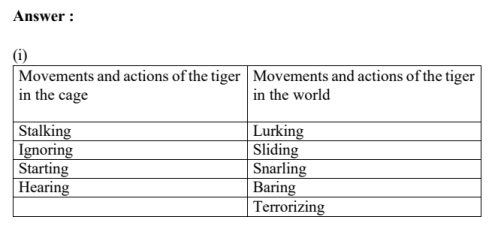SEBA Class 10 English Poem 3 – A Tiger in the Zoo Solutions & Summary (Assamese Medium)
Looking for Class 10 English Poem 3 – “A Tiger in the Zoo” solutions? Ospin Academy provides detailed SEBA solutions in Assamese Medium, focusing on the contrast between a tiger’s life in the zoo and in its natural habitat.
📖 Poem Overview:
Written by Leslie Norris, “A Tiger in the Zoo” presents a sharp contrast between the confinement of a tiger in a zoo and the freedom it enjoys in the wild. The poet expresses sympathy for the majestic animal, highlighting how captivity takes away its natural instincts and beauty.
📌 Key Themes Covered:
- Freedom vs. Captivity
- Emotional Impact of Confinement
- Human Interference in Nature
- The Beauty of the Wild
- Symbolism and Imagery
📌 Important Questions for Exams:
- How does the poet contrast the tiger’s life in the zoo with its life in the wild?
- What emotions does the poet evoke through the poem?
- Explain the significance of the tiger’s movement in the cage.
- How does the poem reflect human interference in nature?
- What poetic devices are used in the poem?
📝 How Ospin Academy Helps:
- Detailed Solutions in Assamese Medium
- Step-by-Step Explanations with Literary Analysis
- Important Exam-Based Questions
- Comprehensive SEBA English Preparation Material
Explore SEBA Class 10 English Poem 3 – “A Tiger in the Zoo” solutions on Ospin Academy and prepare confidently for your exams!
Class 10 English (First Flight & Footprints) PDF Solutions 2025-26 | SEBA Assam
Download Class 10 English (First Flight & Footprints) PDF with textbook solutions, MCQs, and extra exercises for SEBA Assam 2025-26.
Chapter 3
A Tiger in the Zoo
Thinking about the Poem
Q.1 Read the poem again, and work in pairs or groups to do the following tasks.
(i) Find the words that describe the movements and actions of the tiger in the cage and in the wild. Arrange them in two columns.
(ii) Find the words that describes the two places, and arrange them in two columns.
Now try to share ideas about how the poet uses words and images to contrast the two situations.


Q.2 Notice the use of the word repeated in lines such as these:
(i) On pads of velvet quite, In his quite rage.
(ii) And stares with his brilliant eyes At the brilliant stars.
What do you think is the effect of this repetition?
Ans.: (i) The word ‘quite’ has been repeated in these lines. The repetition of the word expressesthe intensity of the tiger’s action.
(ii) ‘Brilliant’ word has been repeated in these lines.
It expresses both the anger and brightness in the eyes of the tiger. It creates an effect of intensity of the action.
Q.3 Read the following two poems – one about a tiger and other about a panther. Then discuss:
Are zoos necessary for the protection or conversation of some species of animals ? Are they useful for educating the public ? Are there alternatives to zoos?
The Tiger
The Tiger behind the bars of his cage growls,
The Tiger behind the bars of his cage snarls,
The Tiger behind the bars of his cage roars,
Then he thinks.
It would be nice not to behind all the bars all The
Time Because they spoil my view
I wish I were wild, not on show.
But if I were wild, hunters might shoot me,
But if I were wild, food might poison me,
But if I were wild, water might
drown me. Then he stops thinking
And…..
The Tiger behind the bars of his cage
growls , The Tiger behind the bars of
his cage snarls,
The Tiger behind the bars of his cage roars,
-Peter Niblett
The Panther
His vision, from the constantly passing bars, has grown so weary that it cannot hold anything else. It seems to him there are a thousand bars; and behind the bars, no world.
As he paces in cramped circles, over and over,
The movement of his powerful soft strides is like a ritual dance around a center in which a mighty will stands paralysed. Only at times, the curtain of the pupils lifts, quietly. An image enters in, rushes down through the tensed, arrested muscles, plunges into the heart and is gone.
-Rainer Maria Rilke
Ans.: Through these two poems, it is clear to all us that freedom is very important for everyone. Not only human beings, but also animals like it deeply. Without freedom, no one can feel happy. Animals in the cage are taken care of. They are given food several times, yet they lead a very pitiable life. They do not like to be caged. They like to move freely, to chase their hunt. They are very powerful, but in the cage, they cannot find proper atmosphere for running and hunting. So, it is very difficult to live in prison.
Although zoos are necessary for the protection or conservation of some species of animals. The dangerous dip in the number of animals in wild has increased the need for the zoos at many places.
Q.4 Take a point of view for or against zoos, or even consider both points of view and write a couple of paragraphs or speak about the topic for a couple of minutes in a class.
Ans.: Zoos are both necessary and as unnecessary. The reasons in favor are more than its opposite idea. That’s why the number of zoos are increasing throughout the world.
Day-by-day the number of many species is decreasing rapidly. So, zoos are important to protect and conserve them. Many species of wild animals have already become extinct. Animals too are very important for this earth and needed to be taken care of.
There are many reasons to say that there are no apparent alternatives of zoos in the current scenario.
Note: Students may add their own ideas to it.
The Greater Cats
The Greater cats with golden eyes Stare out between the bars. Deserts are there, and different skies,
And night with different stars
-Victoria Sackville-West
SEBA Class 10 English Poem 3 – A Tiger in the Zoo FAQs (Assamese Medium)
Get Free NCERT PDFs
If you want to download free PDFs of any chapter, click the link below and join our WhatsApp group:

